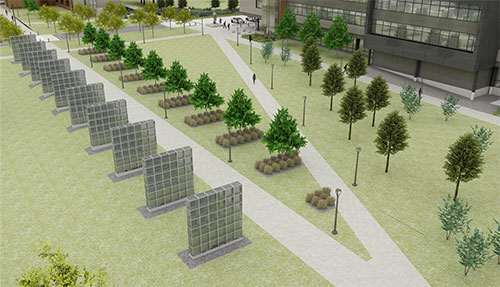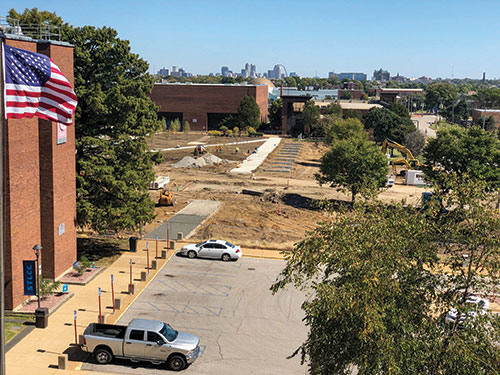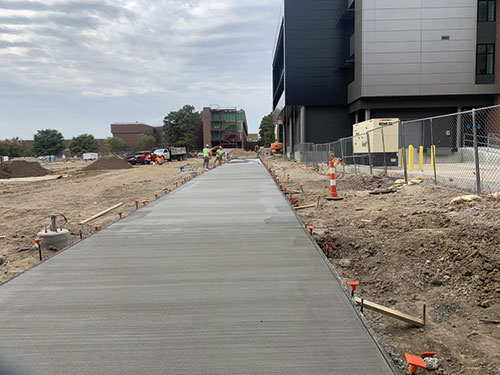
By The Scene staff
Now that A and B towers are gone, Forest Park students, faculty and staff are wondering what the college is going to do with all that space.
The most significant use will be an extension of Highlander Drive from its intersection with College Drive north to Oakland Avenue, west of the new Center for Nursing and Health Sciences.
“You’ll have a straight shot into the campus from Oakland,” said Ken Kempf, manager of St. Louis Community College’s engineering and design staff.
Workers also are installing long, wide concrete walkways between the main campus complex and physical education building that will become part of a quad that officials envision as a central gathering place with seating and landscaping.
One walkway will be flanked by trees and a giant sculpture made of 10 stainless-steel walls that light up at night.
“It’s going to be pretty spectacular,” said Michelle Ohle, a principal with DTLS, a St. Louis landscape architecture company that is designing the grounds as a subcontractor for KAI Enterprises.
“Light Walls” is owned by the Gateway Foundation, a charitable family trust that displays dozens of pieces of artwork in public places throughout St. Louis, including Citygarden.

‘Weathered Venus’ to move
The Gateway Foundation also owns the “Weathered Venus” sculpture that already stands south of C Tower at Forest Park, where it has “limited visibility,” according to a press release from foundation spokesman Paul Wagman.
The 7-foot-tall bronze nude, created by artist Jim Dine, will be moved to the southwest corner of the new Center for Nursing and Health Sciences. It will be surrounded by tables and chairs with more seating built into its base.
“(In the new location) you can really approach her and view her in a way that you couldn’t before when she was surrounded by plantings,” Ohle said.
STLCC spent $39 million to construct the 96,000-square-foot, four-story Center for Nursing and Health Sciences, north of A Tower and west of the physical education building at Forest Park. It opened in the fall of 2019.
“When we originally did the analysis of the campus, the challenge was that people didn’t know how to get in,” Ohle said. “They had to travel all the way around and enter from the back, and that was really problematic for visitors.”

Lights but no fog
“Light Walls” was designed by Peter Walker and Partners, a landscape architecture company in Berkeley, California, which also designed the grounds of the 9/11 Memorial in New York City.
The sculpture stood at Triangle Plaza Park in downtown St. Louis until a few years ago, when it was moved to make way for an expansion of Metro’s Civic Center transit station at 14th and Spruce.
Each of the 10 walls are 15 feet tall, 14 feet wide and 2 feet deep. They will be illuminated by white LED lights from below.
“(The sculpture originally) was known as ‘Fog Walls’ and included a water feature that produced mist, as well as colored fluorescent lights,” the press release stated. “In its new incarnation, the water feature has been eliminated and the colored fluorescent lights replaced with the more environmentally friendly LED technology.”
The foundation will move, install and maintain “Weathered Venus” and “Light Walls,” requiring STLCC only to pay electric bills for the lighting, according to the release.
The Forest Park campus was built on the site of Forest Park Highlands, an amusement park destroyed by fire in 1963. Renowned Chicago architect Harry Weese and landscape architect Dan Kiley designed the campus. Kiley also designed the original Gateway Arch National Park grounds.
